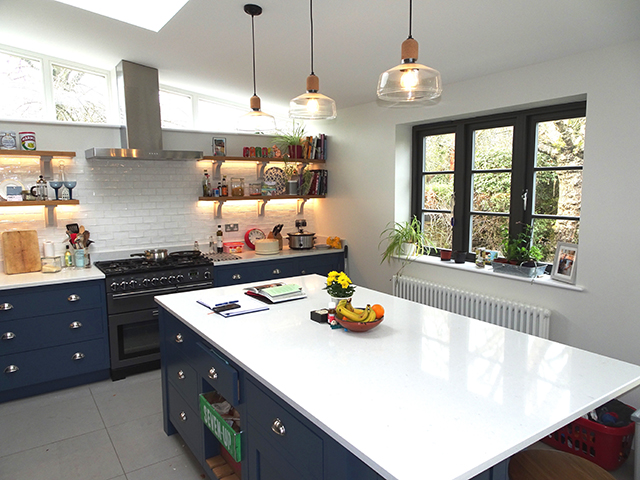What to consider when choosing glazing for your self-build
Glazing is a crucial element of every self-build property - here's what you need to know about doors and windows before you buy.
Specifying doors and windows for your self-build can account for a substantial percentage of your total costs, so it’s essential to do your research and choose wisely.
PROMOTIONAL FEATURE
Image: Aluminium EuroFold doors, Kloeber
In a contemporary self-build, glazing is key – not only for the design of the property but for your budget too.
Grand Designs magazine has teamed up with bespoke glazing specialists Kloeber to create a complete guide to choosing windows and doors for your project, starting with a overview of what you need to consider before you buy.
Window styles
When choosing the style of windows for your home be aware that from a planning perspective, the council will take into consideration the choices you make. Think about how you want the windows to perform. How do you want them to open and close? How will you use them in your home, are they in a room that gets a lot of sun or a room that will not get much use?
Flush casement windows are one of the most popular styles of window in the UK. The opening part or sash is flush with the frame on the exterior face and they normally open outwards. Tilt & Turn windows open inwards and are more popular in mainland Europe. You can clean them from inside and tilt them in for ventilation without compromising security. Vertical sliding sash windows open by sliding the sash up and down within the frame. Most commonly made from timber and used in period properties. Some sash windows may not be great for weather sealing so always check this.
Image: Timber flush casement windows, Kloeber
Door styles
Bifolds can open up to 90% of the aperture so are ideal for smaller openings as you can literally open up a whole wall of your home. There is a variety of configurations to choose from and you could add a single access door to your design. Bifold door units can open inwards or outwards, the latter option allowing you to take full advantage of space inside without the concern of furniture getting in the way. A level threshold with similar flooring inside and outside will help create a cohesive living space with a seamless connection to the outdoors.
If unadulterated views are your dream then perhaps sliding doors are the ideal choice for you. They open up by sliding the panels to one or both sides, with the panes fitting behind each other on two or three tracks and are perfect for larger apertures. There will always be a fixed frame panel therefore the maximum opening will be around 75% but the larger aperture will mean you probably wouldn’t need the whole width to open up anyway. When closed, you can take advantage of those wider panes of glass that will allow unbroken views of your garden and beyond.
French doors can work just as well in a new, modern style property as they do in a period or traditional style property where you don’t want to open up large areas to the outdoors. If you choose a bespoke design, you have the option of inward or outward opening configurations with the master door on either the left or right depending on what works for your project.
Image: Timber French doors, Kloeber
Material choices
Choice of frame materials is a major consideration. The four main options are plastic/uPVC (the more cost effective end of the market), wood, aluminium and alu-clad (composite). Think about your internal and external style and colour scheme of your house. Timber provides a warm aesthetic with great insulating properties but if you prefer thinner frames and larger expanses of glass, then low maintenance aluminium would be the better choice. Alu-clad combines the best of both worlds with the benefits of a wood frame interior with an aluminium exterior.
Type of glass
When choosing glazing think about the properties it could contribute. If your home is south facing then solar control glass would be an option. If it is important to the keep the heat in, do you want to make the investment in triple glazing? If you have hard to reach areas or large expanses of glazing, would a self-cleaning option be more practical? If security is key then laminated glass should be used.
Image: ÜberSlide doors, Kloeber
Security
Security standards are more stringent for new build properties; a door needs to be made to a certain standard that demonstrates its resistance to manual attack either through a physical testing program at an authorised testing facility or through a strict specification (which is only relevant to timber doors). The best way to ensure a product meets the requirements for a new build is to choose a product that has been tested to PAS24 or a product that is Secured By Design certified.
Energy efficiency
Try to attain a low U-value on glazed doors and windows. U-values have to be lower than 2 W/m2 K for a new build but for a high performance glazed door you should look for a U-value of 1.2W/m2 K or less and less than 1.6 W/m2 K for a window. Glass will always let out more heat than a solid wall, so consider triple glazing or a high performing double glazed unit. Thermal properties vary with different frame materials, with timber usually being a good choice. If you are installing glazed doors, consider how they will fold or slide and how they seal up between panels. Thermal and weathertesting reports should be available from reputable companies that sell high performance sliding or folding doors.














